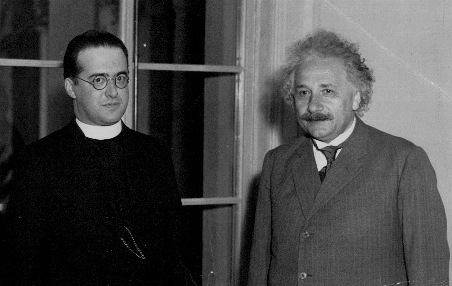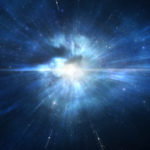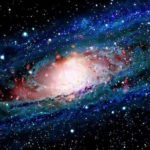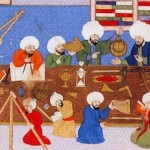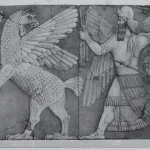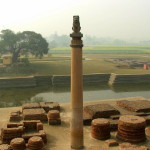Fathers of Science
by Dr. Matthew Bunson
Filed under Christianity and Science
On March 12, 2008, the John Templeton Foundation made the announcement of the winner of its annual Templeton Prize, which honors achievements engaging the great questions of life and the universe. The $1.6 million prize for 2008 went to Michał Heller, a Polish cosmologist and professor in the faculty of philosophy at the Pontifical Academy of Theology in Cracow, Poland. What makes Heller additionally remarkable is that he is a Catholic priest.
The 72-year-old planned to spend the prize money to establish a research institute—named in honor of Nicholas Copernicus—that will seek to reconcile science and theology. Fr. Heller said:
"If we ask about the cause of the universe we should ask about the cause of mathematical laws. By doing so we are back in the great blueprint of God's thinking about the universe; the question on ultimate causality: Why is there something rather than nothing? When asking this question, we are not asking about a cause like all other causes. We are asking about the root of all possible causes. Science is but a collective effort of the human mind to read the mind of God from question marks out of which we and the world around us seem to be made."
As a priest-scientist, Fr. Heller is not unique. Rather, he stands in a long and great tradition of learned priests who were both scientists and men of faith. Some are well-known to history, such as Roger Bacon, the 13th-century Franciscan who stressed the concept of "laws of nature" and contributed to the development of mechanics, geography, and especially optics. Others are obscure. All, however, left a lasting legacy on their eras in learning, science, mathematics, and practical progress.
These priest-scientists affirm what Fr. Georges Lemaître, discoverer of the "Big Bang", robustly proclaimed in 1933: "There is no conflict between religion and science." What follows is a survey of a few of the many priests and scientists who have bettered our world over the centuries. The list does not pretend to be exhaustive, but it serves to undermine the long-perceived conflict between science and religion, evolution, and cosmology.
Fr. Robert Grosseteste (c. 1175-1253)
The Suffolk-born Englishman, Robert Grosseteste of Lincoln, grew up in a poor family but became arguably the most learned figure in England because of his unquenchable desire for knowledge, a deep faith, and personal humility. He was educated in theology and began teaching at Oxford, where he enjoyed an association with the recently arrived Franciscans and where he perhaps served as chancellor. Elected bishop of Lincoln in 1235, he was deeply concerned with reforming the Church in England. He renounced corrupt or unsuitable abbots, reduced ecclesiastical benefices, and authored a series of statutes to provide specific guidelines for the behavior of the clergy and the administration of dioceses.
His achievements as a Church leader, however, were eclipsed by his reputation as one of the most learned men of his age. He was a master of mathematics, optics, and science, foreshadowing the experimental methods of his pupil Roger Bacon. Historians of science claim that Robert was the founder of the scientific movement at Oxford University and so sparked a pursuit of excellence that has continued to today. Among a few of his achievements was a commentary on the Physics of Aristotle, a critique of the Julian calendar that anticipated the reform of the calendar under Pope Gregory XIII 300 years later, and treatises on optics, music, and mathematics. Such was his reputation for genius and knowledge of the natural world that he was also reputed in some unlearned circles to be a wizard and sorcerer.
Fr. Ignazio Danti (1536-1586)
One of the inheritors of the tradition of learning encouraged by Grosseteste was a relatively unknown Italian bishop, Ignazio Danti. The son of an artisan, he was born in Perugia and studied perhaps at the university there before joining the Dominicans in 1555. He went on to earn the patronage of the leading figures of his era, including Cosimo de'Medici in Florence and Popes St. Pius V and Gregory XIII. The latter pope named him bishop of Alatri, where he displayed great zeal for advancing the reform of the Church.
Much like Grosseteste, Danti enjoyed a wide-ranging set of interests, including astronomy, mathematics, optics, architecture, civil engineering, hydraulics, and cartography. He was especially renowned for his skills as an astronomer. In 1574, he made a set of important observations that found the equinox to be 11 days earlier than the calendar. He consequently played a role in the reform of the Julian Calendar under Gregory XIII.
But Danti left his real mark as a cartographer. Cosimo de'Medici commissioned him to prepare maps and a large terrestrial globe for his own collection. He had commissions from Pius V to map Perugia and from Gregory XIII to map the Papal States. His maps can still be seen today in massive murals in the Palazzo Vecchio in Florence and on the walls of La Galleria delle Carte Geografiche of the Belvedere Palace in the Vatican.
Finally, Danti perfected the rado latino, a surveying instrument, and he crafted designs for a canal across Italy that would link the Adriatic and Mediterranean through Florence.
Fr. Marin Mersenne (1588-1648)
The French priest Marin Mersenne began his long career at the recently established Jesuit School in La Flèche—the only school he could find that allowed poor students to attend. Among his fellow students was the eight-year-old René Descartes, who would become a friend. Mersenne entered the Order of the Minims in 1611 and was ordained a priest the next year. After theological studies, he became known in philosophical and theological circles for his fiery works against atheism and deism. History remembers him most, however, for his work in mathematics, especially the so-called Mersenne primes and his effort to find a formula that would represent all prime numbers.
In La vérité des sciences (Truth of the Sciences), he argued for the value of human reason. He corresponded with the foremost figures of his age, including Pierre Gassendi, René Descartes, Pierre de Fermat, Thomas Hobbes, and Blaise Pascal. He organized colloquia of scientists from around Europe to read their papers and exchange ideas. The gatherings became known as the Académie Parisiensis but were also nicknamed the Académie Mersenne, and the number of scientists whose careers were given direction by the colloquia is impossible to underestimate. In keeping with his commitment to science, he left instructions that his body be used for research.
Fr. Jean-Felix Picard (1620-1682)
A contemporary of Mersenne, the French Jesuit Jean-Felix Picard earned the title of founder of modern astronomy in France even as he labored as a priest. Born in La Flèche, where he studied at the Jesuit Collège Royal Henry-Le-Grand, he was fascinated from an early age with the heavens, and he gave his intellectual life to the cause of astronomy. Picard introduced new methods for watching the stars and improved and developed new scientific instruments.
Picard was the first person in the Enlightenment to provide an accurate measure of the size of the Earth through a survey conducted 1669-1670. His calculation of a terrestrial radius of 6328.9 km is off by only 0.44 percent, and his continued progress in instruments proved essential in the drafting of Isaac Newton's theory of universal gravitation. Picard also worked and corresponded with a vast number of scientists of the time, including Isaac Newton, Christian Huygens, and a great rival, Giovanni Cassini.
Deeply respected by his contemporaries but overshadowed by Galileo, Newton, and Cassini, Picard was a founding member of the French Academy in 1666. He was honored in 1935 by having a moon crater named after him. (A less-elevated honor was bestowed in 1987, when his name was used for the character Captain Jean-Luc Picard on the television show Star Trek: The Next Generation.)
Fr. Gregor Mendel (1822-1884)
Far better known than Picard, of course, is the Augustinian abbot Gregor Mendel, the father of modern genetics. Born in Austria to a peasant farmer family, he entered the Augustinian Order in 1843 and was ordained a priest four years later. Mendel was largely unheralded during his life and accomplished his phenomenal work in considerable obscurity while teaching natural science in a boy's high school in Austria. Only in his last years, in fact, was he named an abbot.
Mendel earned his place in science by working with simple pea pod plants. He loved to take walks around the monastery and noticed that some plants were radically different in their traits and growth patterns. As any high school student today can attest, Mendel spent years examining seven characteristics of the pea pod plants and determined the basic laws that govern the passage of traits within a species. Especially crucial was the discovery of dominant or recessive genes, a key to modern genetics and the study of dominant and recessive traits, genotype and phenotype, and the concept of heterozygous and homozygous. Sadly, Mendel was so ahead of his time that science did not recognize his contribution until early in the 20th century. Today, he is world-famous—and often resented by students who must do their own experiments based on his work.
Fr. Armand David (1826-1900)
Around the same time that Mendel was taking his walks around the monastery, the missionary Lazarist priest, zoologist, and botanist Armand David was at work halfway around the world, in China. A native of Bayonne, France, he entered the Congregation of the Mission in 1848 and was ordained a priest in 1862. Sent to the missions in Beijing, he served with distinction in the community. He found China a remarkable opportunity for exploring the natural sciences. Such were his finds in the areas of zoology, botany, geology, and paleontology that the French government asked him to send specimens of his finds back to Paris for further study. These samples, seen for the first time in the West, aroused such a great interest that Fr. David was commissioned by French scientists to explore China in the search for other new discoveries.
Upon his return to France in 1888, he gave a celebrated address in Paris at the International Scientific Congress of Catholics in which he documented his study of more than 60 species of animals and more than 60 species of birds, all of which had been previously unknown. Of particular interest were his "discovery" of the Giant Panda (unknown in Europe) and the Milu Deer, a species of deer subsequently called Père David's Deer (Elaphurus davidianus) in his honor.
Fr. Julius Nieuwland (1878-1936)
The Holy Cross priest Julius Nieuwland was concerned with practical solutions in his field of chemistry. The son of Belgian immigrants, Nieuwland grew up in South Bend, Indiana, and studied at the University of Notre Dame. Ordained a priest in 1903, he went on to graduate studies at The Catholic University of America, where he specialized in botany and chemistry.
Returning to Notre Dame in 1904, he served as a professor in botany and then chemistry, a post he held until his retirement in 1936. In the quiet halls of scientific study, he successfully polymerized acetylene into divinylacetylene. Elmer Bolton, the director of research at DuPont, used this basic research to achieve the development of neoprene. In effect, this humble priest was the inventor of the first synthetic rubber.
Embraced by the DuPont Company, the invention had a major impact on many industries and our daily lives. For example, neoprene is used for electrical cable insulation, telephone wiring, rug backings, and roofing. Fr. Nieuwland also nearly had a major impact on the history of college football when he tried, unsuccessfully, to convince the future coaching legend of Notre Dame, Knute Rockne, to be a chemist instead of a football coach. Not to neglect his botany, Nieuwland roamed throughout swamps and woods looking for suitable specimens for study, and he was famed for using a pistol to shoot them down from high branches. For his work in chemistry, not marksmanship, he was given the Morehead Medal for research in acetylene, the American Institute Medal, and the Nichols Medal, the highest honor of the American Chemical Society.
Fr. Georges Lemaître (1894-1966)
Fr. Georges Lemaître, a Belgian priest, physicist, and mathematician, first proposed the Big Bang Theory for the birth of the universe. Born in Charleroi, Belgium, he studied math and science at Cambridge University after ordination in 1923 and specialized in the then-most-current studies in astronomy and cosmology, especially Einstein's general theory of relativity.
The accepted idea in physics at the time was that the universe was essentially in a changeless state—a "Steady State." Where Einstein saw that the universe was actually moving—either shrinking or expanding—and devised the cosmological constant that maintained the stability of universe, Lemaître concluded that the universe was expanding. Not only that, Lemaître proposed that from this it could be concluded that all matter and energy were concentrated at one point. Hence: The universe had a beginning.
This theory, at first met with great skepticism, was termed rather sarcastically the "Big Bang." For his part, Lemaître elegantly described this beginning as "a day without yesterday." He presented his theory in January 1933 to a gathering of scientists in California, and at the end of his presentation, Einstein applauded and declared, "This is the most beautiful and satisfactory explanation of creation to which I have ever listened." Lemaître's ideas subsequently gained ground. Today, astrophysicists readily accept the Big Bang and the continuing expansion of the universe. For his labors, Lemaître was made a member of the Royal Academy of Belgium and a canon of the cathedral of Malines. In 1936, Pope Pius XI inducted him into the Pontifical Academy of Science.
Fr. Stanley Jaki (b. 1924)
Fathers Nieuwland and Lemaître made manifest that faith and science are not incompatible. The Benedictine priest Stanley Jaki has argued with great eloquence that science itself could develop only in a Christian culture. For his work, he earned the Templeton Prize and in 1990 was named to the Pontifical Academy of Science by Pope John Paul II. Born in Hungary, he earned doctorates in Systematic Theology and Nuclear Physics, is fluent in five languages, and has authored 30 books. A Distinguished Professor at Seton Hall University, Jaki's work in the history and philosophy of science has brought him a wide audience around the world. In a modern scientific world so steeped in Enlightenment philosophy and so opposed to a relationship with religion, Fr. Jaki's assertion that science and religion are consistent and that scientific analysis can shed light on both scientific and theological propositions is a bold one.
As Jaki contends, discoveries of nuclear physics and astronomy have given confirmation of an essential order within the universe. While it is true that our understanding of both fields is incomplete, the Christian perspective demonstrates that the order of the cosmos is entirely consistent with the biblical view of Creation.
Traveling in the footsteps of Lemaître, Jaki has tackled one of the greatest questions in science, cosmology, and has concluded that science permits us to gain insights into the events that followed the instant of creation but offers nothing about what happened before it, when matter itself was created from nothing. He thus boldly challenges the assertions of cosmologists and astrophysicists such as Stephen Hawking that the origins of the universe offer proof for the non-existence of God; rather, the very proposition cannot be proved scientifically because there is nothing to observe. At the same time, God's created order reflects a Creator who is totally rational and infinitely superior to our own way of thinking. Little wonder, then, that such a balanced and positive approach to the natural world that is found in authentic Christian teaching and culture permitted science to flourish.
Fr. Michal Heller (b. 1936)
The great cosmological questions are also the personal field of the Polish priest and physicist Michal Kazimierz Heller, a professor in Cracow, Poland, and a member also of the Pontifical Academy of Sciences since 1990. Fr. Heller is engaged in the highest regions of mathematics and astronomy. Currently, he is researching the singularity problem in general relativity and the use of non-commutative geometry in seeking the unification of general relativity and quantum mechanics. He also concerns himself with philosophy and the history of science and science and theology. In Heller's view, all of these different facets of science point to something truly important about the "blueprint" of Creation.
Other Notable Catholic Scientists
St. Bede, the Venerable (d. 735) An Anglo-Saxon priest, historian, biblical scholar, and one of the greatest of all chroniclers of the Middle Ages. Aside from his historical writings, he was the author of On Time and On the Reckoning of Time.
Pope Sylvester II (d. 1003) A pontiff and scientist who promoted mathematics and astronomy in the Church’s schools.
Hermannus Contractus (d. 1054) A monk and author of works on geometry, mathematics, and the astrolabe.
Pope John XXI (d. 1277) A pontiff and author of an influential work on medicine prior to his election.
St. Albertus Magnus (d. 1280) One of the greatest theologians in the history of the Church and the patron saint of scientists. He is called Universal Doctor.
Roger Bacon (d. 1294) An English Franciscan who helped to establish the laws of nature and wrote on geography, mechanics, and optics. He is honored as the "Amazing Doctor".
Theodoric of Freiberg (d. c. 1310) A member of the Dominicans best known for explaining the rainbow in On the Rainbow.
Thomas Bradwardine (d. 1349) English archbishop who helped advance the principles of mechanics. He is honored as the Profound Doctor.
Nicole Oresme (d. 1382) French philosopher, bishop of Lisieux, and mathematician. He wrote on economics, mathematics, and the natural sciences, and his studies with Jean Buridan of moving bodies foreshadowed the work of Leonardo da Vinci and Copernicus.
Nicholas of Cusa (d. 1464) A German theologian, humanist, mystic, expert in canon law, and a cardinal, he also made contributions to the field of mathematics by developing the concepts of the infinitesimal and of relative motion. His philosophical speculations also anticipated Copernicus’ heliocentric worldview.
Bl. Nicolas Steno (d. 1686) A convert from Lutheranism, he was beatified by Pope John Paul II in 1987. He brought advances in the areas of anatomy, geology, and paleontology.
Bl. Francesco Faà di Bruno (d. 1888) An Italian priest and spiritual writer who made immense contributions to mathematics, including a famous formula. He was beatified by Pope John Paul II in 1988.
Related Posts
Note: Our goal is to cultivate serious and respectful dialogue. While it's OK to disagree—even encouraged!—any snarky, offensive, or off-topic comments will be deleted. Before commenting please read the Commenting Rules and Tips. If you're having trouble commenting, read the Commenting Instructions.




